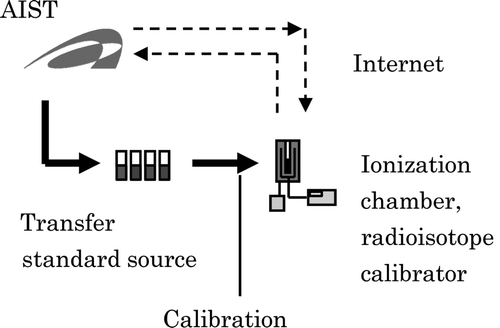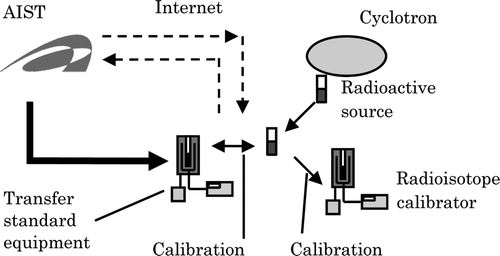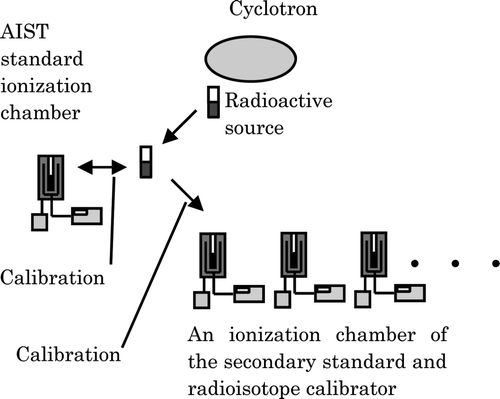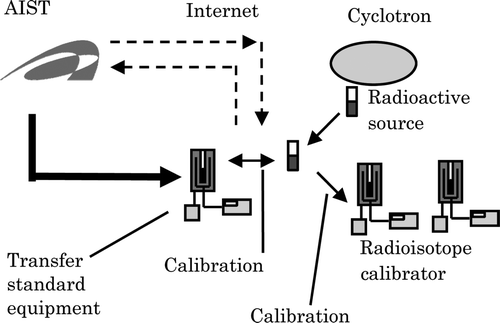Abstract
A new calibration technique, referred to as e-trace, has been developed by the National Institute of Advanced Industrial Science and Technology (AIST). The e-trace technique enables rapid remote calibration of measurement equipment and requires minimal resources. We calibrated radioisotope calibrators of the Japan Radioisotope Association (JRIA) and the Nishina Memorial Cyclotron Center (NMCC) remotely and confirmed that remote calibration provided results that are consistent with the results obtained by existing methods within the limits of uncertainty. Accordingly, e-trace has been approved as the standard calibration method at AIST. We intend to apply remote calibration to radioisotope calibrators in hospitals and isotope facilities.
1. Introduction
A new e-trace calibration technique has been developed by the National Institute of Advanced Industrial Science and Technology (AIST) to rationalize traceability [Citation1]. A traceability system for use with radioactivity is shown in . National Metrology Institutes (NMIs) have been established in order to develop and maintain national metrology standards for one or more quantities [Citation2]. The Mutual Recognition Arrangement (MRA) is an agreement between NMIs of member states of the Metre convention [Citation3]. The primary objective of the MRA is to provide governments and other parties with a secure technical foundation for wider agreement related to international trade, commerce, and regulatory affairs. This objective is reached through international comparison of measurement standards, peer review of the declared calibration and measurement capabilities, the quality management system, and demonstration of competence. A calibration laboratory is a laboratory that performs calibration for one or more quantities. A working standard is a standard that is routinely used to calibrate or verify measurement instruments or systems. A transfer standard is an intermediary to compare measurement standards.
Traceability is an unbroken chain, in which measurement equipment is calibrated by references at higher levels, with the calibration chain ending at the primary standard. The traceability system for radioactivity in Japan is as follows [Citation4]. As one of NMIs, AIST possesses a radioactivity primary standard that consists of 4 πβ–γ coincidence counters, pressurized ionization chambers, Ge-semiconductor detectors, liquid scintillation counters, and charged particle detectors, and maintains and supplies national standards. The Japan Radioisotope Association (JRIA), as an ISO/IEC 17025 accredited calibration laboratory, possesses a secondary standard [Citation5]. The JRIA supplies radioactivity reference sources for lower-class calibration laboratories and end-users and carries out calibration of their reference standards. These calibration laboratories possess working standards and provide calibration services for end-users. In addition, AIST participates in international comparisons of measurement standards and has secured the equivalence of national standards.
By conventional methods, measurement instruments must be sent to an NMI or a calibration laboratory, or service personnel must come to remote locations at which the measurement instruments are located. While measurement instruments are located in an NMI or a calibration laboratory, the equipment cannot be used, and when service personnel come to such remote locations, the costs of calibration increases. Thus, we tried to apply Internet technology to calibration techniques in order to solve these problems. The e-trace technique allows calibrations in shorter times and with less expense than conventional methods. When ionization chambers and/or radioisotope calibrators are calibrated after business hours by e-trace, measurement using the ionization chambers and/or radioisotope calibrators can continue uninterrupted.
The e-trace technique enables the rapid remote calibration of measurement equipment and requires minimal resources. The e-trace concept is as follows. An NMI or a calibration laboratory sends transfer standards to customers. Measurement equipment at a remote location is controlled via the Internet, and transfer standard data are obtained. The work of authorized personnel at the remote location is monitored by video-conferencing. The measurement data are analyzed by an NMI or a calibration laboratory before a certificate of calibration is issued. All of the calibration methods for maintaining traceability are managed based on a quality management system, such as ISO/IEC 17025.
Many hospitals currently use radiopharmaceuticals for in vivo diagnostic imaging. Single photon emission computed tomography (SPECT) and positron emission tomography (PET) are useful methods for obtaining physiological information, such as the presence and location of cancer, following the injection of a radiopharmaceutical. Radioisotope calibrators, which are a type of ionization chamber, are commonly used to measure the activity of radiopharmaceuticals and confirm that an adequate amount of radionuclide is injected. The e-trace technique is applied to ionization chambers and radioisotope calibrators to enable rapid calibration of ionization chambers and radioisotope calibrators nationwide using limited resources.
The e-trace technique is especially useful for calibration using short-half-life nuclides. When ionization chambers and/or radioactivity calibrators are calibrated, activities of transfer standard sources are first measured. However, activity measurement of transfer standard sources must be conducted at a calibration laboratory by now. Calibrating ionization chambers and/or radioactivity calibrators using short half-life nuclides is difficult because the activities of the sources decay quickly during transportation and calibration of transfer standard sources. On-site activity measurement for transfer standard sources, at the production site, can be carried out by e-trace. Thus, ionization chambers and radioisotope calibrators in the remote locations are calibrated within a short time by e-trace after the transfer standard sources have been produced.
2. Remote calibration method
Two methods of remote calibration were examined. One uses transfer standard sources, while the other uses transfer equipment. The former is assumed to be used primarily for ionization chambers as the secondary standard, and the latter is assumed to be used for radioisotope calibrators with short half-life isotopes.
2.1. Using transfer standard sources
A schematic diagram of remote calibration using transfer standard sources is shown in . The National Institute of Advanced Industrial Science and Technology calibrates the activity of transfer standard sources before they are sent to radioisotope calibrators’ users. The standard sources are protected by the structure shown in during shipping. A standard source is stored in a plastic container with inner plastic cushions at both the top and the bottom. A piece of cushion paper is sandwiched between a standard source and an inner plastic cushion. The plastic container is placed in a lead shield, and lead shields are placed into a metal container with inner plastic cushions.
Figure 2. Schematic diagram of remote calibration using transfer standard sources. The National Institute of Advanced Industrial Science and Technology calibrates transfer standard sources before sending them to users. The standard sources are measured using an ionization chamber and/or radioisotope calibrator via the Internet, and measured data are also transferred to AIST via the Internet. The calibration coefficient is calculated using the measured activity and the activity of the standard source. For the case in which the ionization current is obtained, the sensitivity is calculated using the measured current and the activity of the standard source.

Figure 3. Plastic container and lead shield for a standard source. A standard source is stored in a plastic container with inner plastic cushions on both the top and the bottom. A piece of cushion paper is sandwiched between the standard source and an inner plastic cushion. The plastic container is placed in a lead shield, and lead shields are placed into a metal container along with inner plastic cushions.

The transfer standard sources are measured by the ionization chambers and/or radioisotope calibrators, which are controlled via the Internet, and measured data are transferred to AIST via the Internet [Citation6]. The calibration coefficient of the radioisotope calibrator is calculated from the measured activity and the activity of the transfer standard source is as follows:
For a standard ionization chamber of the secondary standard in JRIA, the sensitivity defined as current/activity ratio Ca is calculated instead of the calibration coefficient:
The operation of the standard source is checked by visual inspection because activity does not change as long as leakage does not occur.
2.2. Using transfer equipment
A schematic diagram of remote calibration using transfer equipment is shown in . When using transfer equipment such as a radioisotope calibrator, the radioactive source produced on-site is calibrated by a transfer radioisotope calibrator controlled via the Internet. This calibrated source is measured by the radioisotope calibrator and the calibration coefficient is then calculated based on the measured activity. The operation of the transfer radioisotope calibrator is checked using a sealed standard source before sending the calibrator to a remote place and after the calibrator has been returned. This method is applied to short-lived nuclides such as 18F.
Figure 4. Schematic diagram of remote calibration using transfer equipment. The radioactive source produced on-site is calibrated remotely using transfer standard equipment, i.e., a transfer radioisotope calibrator. The calibrated source is measured using the radioisotope calibrator of interest, and the calibration coefficient is calculated using the measured activity.

3. Remote calibration experiments
3.1. Remote calibration experiment using transfer standard sources
An ionization chamber measures radioactivity. The activity of a radioisotope is determined by measuring the ionization current created by radiation.
The ionization chamber is calibrated by obtaining the sensitivity as the ratio of the ionization current in an ionization chamber to the activity of a radioactive standard source.
The remote calibration system between JRIA and AIST was constructed in the following manner. The AIST computer and the JRIA ionization chamber system were connected via the Internet. The JRIA ionization chamber system consisted of an ionization chamber, a high-voltage supply, an electrometer, and a computer. We used a Centronic IG11N20 ionization chamber [Citation7]. The ionization current was measured using an electrometer (Keithley 6517A) that was connected to a computer via a GPIB cable [Citation8]. The JRIA used an asymmetric digital subscriber line (ADSL) to connect the computer to the Internet and avoid interference from their LAN. The National Institute of Advanced Industrial Science and Technology has an access-free zone (AFZ), in addition to the AIST LAN, which we used to connect the computer to the Internet. Software (Desktop On-Call) was used to control the JRIA computer and ionization chamber from AIST [Citation9]. A video-conferencing system was used between AIST and JRIA to visually confirm placement of the radioactive source in the ionization chamber.
The transfer standards for 109Cd, 57Co, 139Ce, 85Sr, 137Cs, 134Cs, 60Co, and 88Y were prepared as a hydrochloric acid solution and sealed in glass ampoules. The activities of these sources were calibrated using ionization chambers of primary standards at AIST (a Centronic IG11A20 chamber and two Centronic IG11N20 chambers). The sources were identical to the radioactive sources used for the Asia Pacific Metrology Program (APMP) international comparison, which enables consistent radioactive measurements in the Asia-Pacific area [Citation10].
The sources were sent to JRIA where the ionization current from an ionization chamber located at JRIA was measured remotely. The sensitivities were then calculated using Equation (2). The results of the remote calibration experiment between JRIA and AIST are shown in . The differences in sensitivities in this case are mostly caused by the uncertainty in repeated current measurement.
Table 1. Remote calibration experiment between AIST and JRIA using a transfer standard source.
The obtained sensitivities were equal to ordinary values, within acceptable limits of uncertainty. Thus, the ionization chamber at JRIA was successfully calibrated by remote calibration.
3.2. Remote calibration experiment using transfer equipment
The Nishina Memorial Cyclotron Center (NMCC) and the National Institute of Radiological Sciences (NIRS) produce [18F] Fluorodeoxyglucose ([18F] FDG) for use in PET. In practical use, the activity of the [18F] FDG solution is measured using a radioisotope calibrator before injection. In the present study, the radioisotope calibrator was calibrated using [18F] FDG sealed into glass vials as a standard source.
3.2.1. Conventional calibration
Prior to the remote calibration experiment, we performed a calibration test using [18F] FDG at NMCC, NIRS, and JRIA to compare the results of remote calibration ( and ).
Figure 5. Schematic diagram of the conventional calibration experiment at NMCC. The activities of radioactive sources were determined using an AIST standard ionization chamber. An ionization chamber of the secondary standard and radioisotope calibrators were calibrated.

Figure 6. Schematic diagram of the conventional calibration experiment at NIRS and JRIA. The activities of radioactive sources were determined using AIST transfer standard equipment. Radioisotope calibrators at NIRS and ionization chambers of the secondary standard at JRIA were calibrated. In order to simulate the delivery of [18F]FDG to hospitals, [18F]FDG was sent to JRIA and measured at JRIA.
![Figure 6. Schematic diagram of the conventional calibration experiment at NIRS and JRIA. The activities of radioactive sources were determined using AIST transfer standard equipment. Radioisotope calibrators at NIRS and ionization chambers of the secondary standard at JRIA were calibrated. In order to simulate the delivery of [18F]FDG to hospitals, [18F]FDG was sent to JRIA and measured at JRIA.](/cms/asset/246313a3-38e0-483c-ab90-517b00bac780/tnst_a_703947_o_f0006g.gif)
At NMCC, the activities of the [18F] FDG sources were determined using the AIST standard ionization chamber, which was brought to NMCC. At the same time, the activities of the sources were measured using an ionization chamber of the secondary standard possessed by JRIA, radioisotope calibrators possessed by AIST and JRIA that were brought to NMCC, and NMCC radioisotope calibrators, the calibration coefficients of which were then obtained ().
Figure 7. Schematic diagram of the remote calibration experiment at NMCC. The radioactive source produced at NMCC was calibrated remotely using AIST transfer standard equipment. The calibration coefficients of the NMCC radioisotope calibrators were then obtained based on the activity of the source and indicated values of the radioisotope calibrators.

Figure 8. Calibration coefficients of ionization chambers and radioisotope calibrators using [18F] FDG. Data (A–F) show the results of the conventional method experiment at NMCC, and data (I–L) show the results of the conventional method experiment at NIRS and JRIA. The experiment at NMCC was conducted in order to calibrate radioisotope calibrators and an ionization chamber of the secondary standard using an AIST standard ionization chamber. The experiment at NIRS and JRIA was conducted in order to prepare remote calibration experiments in hospitals. In order to simulate the delivery of [18F]FDG to hospitals, [18F]FDG was sent to JRIA and measured in JRIA. Data (G–H) show the results of the remote calibration experiment between AIST and NMCC. The calibration coefficients all show that the measured activities of the ionization chambers and radioisotope calibrators were equal to the activity measured by the AIST standard chamber (A) within the limits of uncertainty.
![Figure 8. Calibration coefficients of ionization chambers and radioisotope calibrators using [18F] FDG. Data (A–F) show the results of the conventional method experiment at NMCC, and data (I–L) show the results of the conventional method experiment at NIRS and JRIA. The experiment at NMCC was conducted in order to calibrate radioisotope calibrators and an ionization chamber of the secondary standard using an AIST standard ionization chamber. The experiment at NIRS and JRIA was conducted in order to prepare remote calibration experiments in hospitals. In order to simulate the delivery of [18F]FDG to hospitals, [18F]FDG was sent to JRIA and measured in JRIA. Data (G–H) show the results of the remote calibration experiment between AIST and NMCC. The calibration coefficients all show that the measured activities of the ionization chambers and radioisotope calibrators were equal to the activity measured by the AIST standard chamber (A) within the limits of uncertainty.](/cms/asset/4cc0280a-866b-45b9-b9be-b9bfdf5938eb/tnst_a_703947_o_f0008g.gif)
The same experiment was carried out at NIRS and JRIA. As transfer standard equipment, an AIST radioisotope calibrator was brought to NIRS, and radioisotope calibrators at NIRS were used for the experiment, in addition to the ionization chambers of the secondary standard in JRIA. Initially, the [18F] FDG sources produced at NIRS were used for calibration of the NIRS radioisotope calibrators before one of the [18F] FDG sources was sent to JRIA and measured using the ionization chambers of the secondary standard in JRIA. The calibration coefficients for the ionization chambers of the secondary standard and the NIRS radioisotope calibrators were obtained using the radioisotope calibrator of AIST as transfer standard equipment. In this case, the calibration coefficients of the ionization chambers of the secondary standard were calculated from the sensitivity retained at JRIA. The calibration coefficients of these experiments are presented in Figure 8.
3.2.2. Remote calibration
The same experiment was carried out using a remote calibration system that was constructed between NMCC and AIST (). The radioisotope calibrator was sent to NMCC as transfer equipment and was controlled remotely. In this case, the NMCC-LAN and AIST AFZ were directly connected and the radioisotope calibrator was controlled via a computer connected to the LAN. Real VNC software was used to control the computer and the radioisotope calibrator [Citation11]. The Secure Shell (SSH) protocol was used to secure communication [Citation12]. The radioisotope calibrator can be controlled from AIST using this configuration.
The [18F] FDG source in the glass vial produced by NMCC was calibrated remotely using the transfer standard equipment. The [18F] FDG source was measured by NMCC radioisotope calibrators. The calibration coefficients of the NMCC radioisotope calibrators were obtained using Equation (1). The calibration coefficients of these experiments are shown in . The results of remote calibration are in agreement with the results of the calibration test experiments. The operation of the transfer radioisotope calibrator was checked at AIST before sending the calibrator to NMCC and after returning the calibrator by reading the indicated value produced by a Ho-166m sealed source. No trouble was encountered in shipping the transfer radioisotope calibrator. A robust checking source for transfer standard equipment will be developed in order to conduct operation checks at remote locations.
The results of these experiments prove that remote calibration is as reliable as conventional calibration. Thus, we initiated remote calibration services for ionization chambers and radioisotope calibrators.
4. Remote calibration services
The first calibration service performed at AIST was the remote calibration of an ionization chamber of the secondary standard and a radioisotope calibrator at JRIA using the transfer standard 99mTc, which is widely used for SPECT. In this case, we estimated the sensitivity of a standard ionization chamber and a radioisotope calibrator. The transfer standard 99mTc source is produced at JRIA. The ionization currents of the ionization chamber and radioisotope calibrator were obtained remotely from AIST via the Internet. The transfer standard 99mTc source was then sent to AIST, and the activity of the source was determined by absolute measurement. The sensitivity of the ionization chamber and the radioisotope calibrator at JRIA as determined by Equation (2) were calculated from the ionization current and activity of 99mTc. Certificates of calibration for the standard ionization chamber and the radioisotope calibrator installed at JRIA were then issued by AIST. Using this technique, neither calibration personnel were required to travel, nor were the transportation of the subjects of calibration required. Consequently, staff travel time and the transportation costs for calibration equipment were reduced in comparison with the conventional calibration technique. After this calibration, the method of connection between AIST and JRIA was changed in order to reduce maintenance work required for AFZ and ADSL. The computers of the AIST LAN and JRIA LAN were connected by the RemoteView service [Citation13]. In addition to the ordinary calibration service, AIST provides a calibration service based on the Japan Calibration Service System (JCSS) [Citation14], and the JCSS calibration for ionization chambers as the secondary standard was switched to e-trace with RemoteView. shows the results of remote calibration between AIST and JRIA. We intend to apply the remote method to the calibration of radioisotope calibrators in hospitals and isotope facilities.
Table 2. Results of remote calibration service between AIST and JRIA.
5. Conclusions
Remote calibration experiments were performed and provided results were consistent with those of conventional calibration within the limits of uncertainty. As a result, the e-trace technique has been approved as a regular calibration method at AIST.
Acknowledgement
The present study was supported by the New Energy and Industrial Technology Development Organization, project code P01029.
Additional information
Notes on contributors
Yasushi Sato
†Present address: Juntendo University, 2-1-1 Bunkyo, Hongo, Tokyo 113-8421, Japan.#Present address: Nagoya University, Furo, Chikusa, Nagoya 464-8603, Japan.References
- Yoshida , H. 2001 . The concept of e-measure [in Japanese] . AIST Today 1 , : 26 – 27 .
- Howarth , P and Redgrave , F . 2009 . “ Metrology in short, EURAMET ” . Available at http://www.euramet.org/fileadmin/docs/Publications/Metrology_in_short_3rd_ed.pdf
- Mutual Recognition of National Measurement Standards and of Calibration and Measurement Certificates Issued by National Metrology Institutes . 2003 . Available at http://www.bipm.org/utils/en/pdf/mra_2003.pdf
- Sato , Y. 2003 . Radioactivity standard and remote calibration [in Japanese] . AIST Bull. Metrol , 2 : 141 – 144 .
- ISO/IEC 17025 . 2005 . “ General requirements for the competence of testing and calibration laboratories ” . International Organization for Standardization . Available at: http://www.iso.org/iso/catalogue_detail.htm?csnumber=39883
- Sato , Y. , Hino , Y. , Yamada , T. and Matsumoto , M. 2004 . The remote calibration of radioactivity measurement equipment . KEK Proc , 2004–14 : 213 – 218 .
- Centronic Ltd . Available at http://www.centronic.co.uk/
- Keithley Instruments Inc. Available at http://www.keithley.com/
- Desktop On-Call is a registered trademark of International Business Machines Corporation . Available at http://www.ibm.com/
- Sato , Y. , Yunoki , A. , Hino , Y. and Yamada , T. 2006 . Response calculation for standard ionization chambers in APMP using EGS4 Monte Carlo code . Appl. Radiat. Isot , 64 : 1211 – 1214 .
- RealVNC is a trademark of RealVNC Ltd . Available at http://www.realvnc.com/
- ssh is a registered trademark of SSH Communications Security Corporation . Available at http://www.ssh.com/
- RemoteView . Available at https://rview.net
- Japan calibration Service System . Available at http://www.iajapan.nite.go.jp/jcss/index.html
